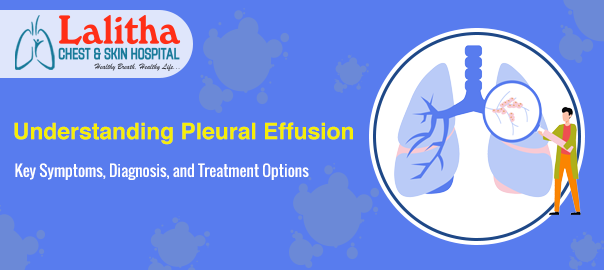Do you experience a sharp, stabbing pain in your chest that intensifies with deep breaths or coughing? Are you struggling with shortness of breath, even when lying down? These could be signs of pleural effusion, a condition where excess fluid accumulates in the space surrounding your lungs.
“Picture your lungs being embraced by a thin, double-layered membrane called the pleura. These layers elegantly line both your lungs and the inner chest wall, sculpting a fluid, lubricated space. With each inhale and exhale, the pleura facilitates the effortless expansion and contraction of your lungs. Yet, when excess fluid interrupts this delicate dance, it can result in breathing difficulties and chest pain”, says Dr. Raj Kumar Korra, the best chest pain doctor in Karimnagar.
With his input, we go deep into this medical condition, explaining the symptoms, diagnosis, and treatment options available for Pleural Effusion.
Common symptoms of pleural effusion:
- Sharp chest pain: This pain often worsens with coughing, deep breathing, or specific body positions.
- Shortness of breath (dyspnea): You may feel a constant struggle to breathe, especially when lying down.
- Dry cough: A persistent, unproductive cough can be a telltale sign of pleural effusion.
- Rapid, shallow breathing: Your body may try to compensate for breathing difficulties by taking rapid, shallow breaths.
- Fatigue: The effort of breathing can leave you feeling constantly exhausted.
Diagnosing pleural effusion:
- Doctor’s exam: Your doctor will listen for abnormal breath sounds using a stethoscope.
- Imaging tests: Chest X-rays reveal the presence and location of fluid. Ultrasounds offer a clearer picture and help guide fluid sampling (thoracentesis) if needed.
- Thoracentesis: A needle is inserted into the chest cavity to withdraw fluid for analysis. This helps identify the cause (infection, heart problems, etc.) and relieves pressure on the lungs.
- Additional tests: Blood tests may be done to check for underlying conditions. In some cases, a CT scan might be needed for a more detailed view.
- Working together: By combining these steps, your doctor can diagnose pleural effusion and determine the best course of treatment.
What causes pleural effusion?
Several underlying conditions can contribute to pleural effusion. Here’s a breakdown of some common culprits:
- Heart failure: When your heart weakens and struggles to pump blood efficiently, fluid can back up into the lungs and the pleural space.
- Pneumonia: Lung infections trigger inflammation and fluid buildup in the pleural space as your body fights off the infection.
- Liver cirrhosis: Scarring of the liver disrupts blood flow, leading to fluid accumulation throughout the body, including the pleural space.
- Cancer: Lung cancer or tumors near the lungs can either obstruct the drainage of fluid or directly cause fluid production in the pleura.
- Blood clots (pulmonary embolism): Blood clots lodged in the lungs can damage tissues and lead to fluid buildup.
- Kidney disease: When your kidneys malfunction, they can struggle to remove excess fluid from the body, resulting in fluid accumulation in the pleural space.
- Autoimmune diseases: Conditions like lupus can trigger inflammation in the pleura, leading to fluid accumulation.
What precautions must be taken to prevent pleural effusion?
- Consult a healthcare provider: Always seek medical advice and follow the recommendations of your healthcare provider. They can provide personalized guidance based on your specific condition.
- Treat underlying causes: Addressing the underlying cause of pleural effusion is crucial. This may involve treating infections, managing heart failure, addressing cancer, or managing other conditions contributing to the fluid build-up.
- Medication compliance: If your doctor prescribes medications such as diuretics (water pills) to reduce fluid build-up, take them as directed.
- Monitor symptoms: Pay attention to any changes in symptoms such as difficulty breathing, chest pain, or worsening cough. Report these changes to your healthcare provider promptly.
- Dietary changes: In some cases, dietary modifications such as reducing sodium intake may help manage fluid retention.
Treatment for pleural effusion:
Once the cause of pleural effusion is identified, treatment can begin to address the root problem and relieve your symptoms. Here’s an overview of some potential treatment strategies:
- Medications: Diuretics help reduce fluid accumulation caused by heart failure by increasing urine output. Antibiotics combat infections like pneumonia.
- Fluid drainage: Procedures like thoracentesis involve inserting a needle into the chest cavity to remove excess fluid, alleviate pressure, and improve breathing.
- Pleurodesis: This minimally invasive procedure aims to prevent future fluid buildup by creating scar tissue between the pleural layers, effectively “welding” them together. This procedure is often used when fluid keeps re-accumulating after drainage.
If you’re noticing signs that could indicate pleural effusion, it’s vital to seek medical help promptly. Swift diagnosis and tailored treatment are key to managing the condition effectively and avoiding potential complications. With that in mind, we strongly recommend booking an appointment with the nearby respiratory hospital to address your concerns.
If you are in Karimnagar and querying Google Search with keywords like “lung specialist near me” or “best chest specialist near me, then let us save you time.
Lalitha Chest and Skin Hospital is the best chest hospital in Karimnagar with an exceptional track record in treating all types of Pleural Effusion cases. Under the expertise of Dr. Raj Kumar Korra, a prominent lung specialist in Karimnagar, we provide comprehensive care for all lung-related issues. To schedule your appointment, visit our website for an appointment here: https://lalithachestandskinhospital.com/



I’m not that much of a internet reader to be honest but your sites really nice, keep it up!
I’ll goo ahead and bookmark yoiur site to come
back down the road. Many thanks https://evolution.ORG.Ua/